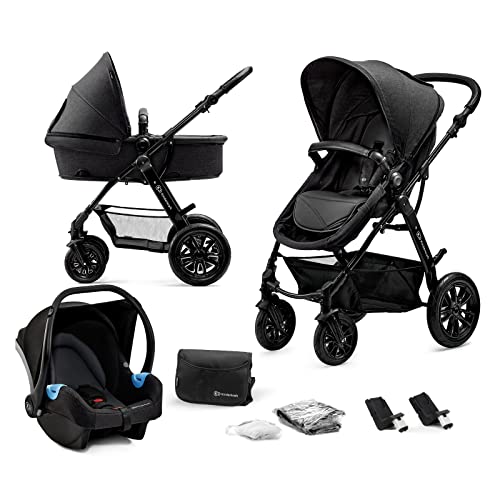Understanding Pushchairs and Prams: A Comprehensive Guide
When it comes to baby mobility, the terms "pushchair" and "pram" are typically utilized interchangeably. However, they represent distinct types of baby carriers, each engineered for particular phases of a kid's development and differed parental requirements. This article looks into the crucial differences in between pushchairs and prams, their functions, types, and considerations for brand-new parents.
What is a Pushchair?
A pushchair, frequently understood as a stroller in some areas, is created for children who can sit up separately. Normally, pushchairs are contemporary, light-weight, and have a seat that can be reclined for added convenience. They may also include a five-point harness to ensure the child's safety while on the go.
Secret Features of Pushchairs
- Light-weight Design: Most pushchairs are made from lighter products, making them easy to navigate and transfer.
- Adjustable Seats: Many designs provide recline options, dealing with resting or active positions.
- Canopy: Most pushchairs come equipped with a sunshade or canopy to protect the child from sun direct exposure.
- Storage Space: They usually consist of a lower storage basket, ideal for holding diaper bags or shopping.
Common Types of Pushchairs
- Standard Pushchairs: Traditional alternatives ideal for kids who can sit independently.
- Umbrella Strollers: Lightweight, compact, and simple to fold; ideal for traveling.
- All-Terrain Strollers: Built with bigger wheels for off-road abilities and smooth rides on varied surface areas.
- Travel Systems: Combines a stroller and a baby safety seat, enabling parents to move their child effortlessly.
What is a Pram?
A pram, brief for "perambulator," is mainly developed for infants, generally from birth until roughly six months. Prams are structured with a flat lying position that supports a newborn's anatomy, ensuring they are nestled appropriately.
Secret Features of Prams
- Flat Bed Design: Prams have a completely flat bed, which is important for young babies who need to lie flat for comfort and health.
- Stylish Aesthetics: Many prams boast vintage or traditional styles, often seen with elegant fabrics and appealing finishes.
- Suspension System: Quality prams often consist of a suspension system to offer a smoother trip over rough surface.
- Extended Canopy: Extended sun security and rain covers prevail.
Typical Types of Prams
- Timeless Prams: Featuring a conventional style, these are typically styled to evoke nostalgia.
- Convertible Prams: These can rapidly change from a pram to a pushchair and generally grow with the kid.
- Lightweight Prams: More compact than standard prams, making them easier to transfer.
Differences Between Pushchairs and Prams
| Feature | Pushchair | Pram |
|---|---|---|
| Use Case | For kids who can stay up | For newborns and infants |
| Design | Upright seat with reclining option | Flat bed for lying down |
| Weight | Generally lighter | Heavier due to tough construction |
| Density | Folds quickly and compactly | May be bulkier, depending upon design |
| Age Range | 6 months to 4 years or older | Birth to around 6 months |
| Price Range | More affordable choices available | Typically more pricey due to products and style |
Picking Between a Pushchair and Pram
When choosing between a pushchair and a pram, several aspects call for consideration:
- Age of the Child: Newborns require a pram; older babies and toddlers will be more comfy in a pushchair.
- Way of life Needs: Parents who travel often might choose lightweight pushchairs, while those searching for comfort in design may favor prams.
- Budget plan: Prams can vary from moderately to costly; trustworthy pushchairs can accommodate budget-conscious consumers.
- Storage Space: Consider how quickly the picked model can suit your car trunk or home storage.
Frequently asked questions
Q1: Can I utilize a pushchair for a newborn baby?
While certain pushchairs are developed with reclining features that might accommodate infants, it is normally suggested to utilize a pram or specifically designed baby safety seat for newborns.
Q2: Are travel systems worth the financial investment?
Travel systems can supply convenience by combining a car seat and a stroller. They enable smooth transition from vehicle to stroller, which numerous parents find important.
Q3: How do I preserve my pushchair or pram?
Regularly clean the material, look for mechanical problems, and lubricate the wheels. Ensure to follow specific care directions provided by the manufacturer.
Q4: What is the weight limitation for pushchairs and prams?
Weight limitations vary by design: typically, pushchairs accommodate approximately 50 pounds, while prams fit babies up to 30 pounds. Always describe the maker's standards.
Q5: Is it necessary to have a rain cover for my pushchair or pram?
Yes, a rain cover can protect your child from rain and wind, preserving convenience while preventing damp clothing.
In summary, pushchairs and prams serve crucial but unique functions in the mobility landscape for parents and caretakers. Selecting the ideal model depends on the kid's age, way of life requirements, and family preferences. By comprehending the characteristics, advantages, and distinctions between pushchairs and prams, moms and dads can make informed decisions that ensure convenience and safety for their child. Whether walking through pushchairsandprams or navigating busy streets, the ideal movement option is out there waiting.

